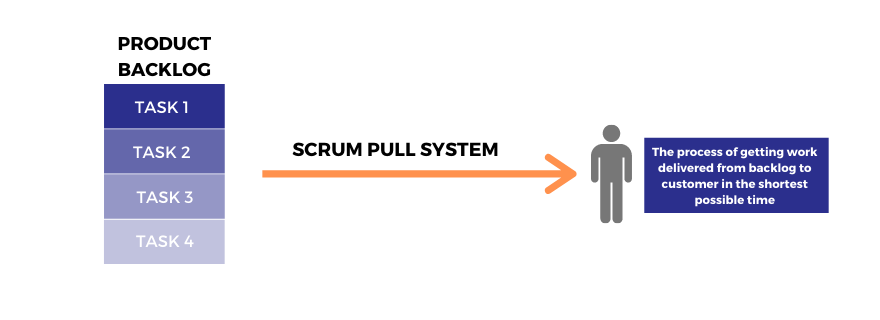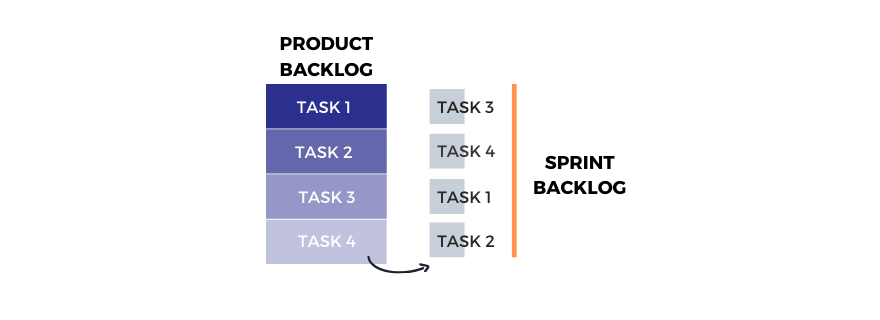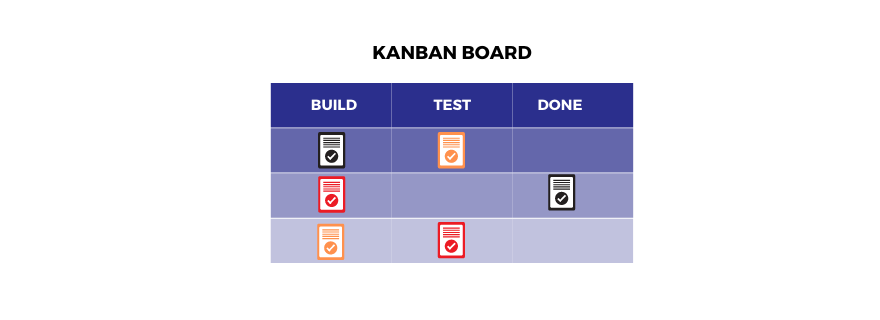Last Updated on: September 29, 2022
When it comes to Product Management, a lot of syllables come into the picture. Terms like Scrum, Agile, Kanban are spread like pieces of Jigsaw on the product management platform, which may be a little difficult to be understood by a new learner.
Let me arrange the puzzle for you in a systematic way.
“In terms of Product management, Scrum and Kanban are the two Agile Software methodologies undertaken by the team to carry out a specific task and fulfil organisational goals.”
But then, how can you differentiate between these two terminologies, Scrum and Kanban? Are they even the same or different?
Let us understand the frameworks and principles which distinguish these two product values.
In every organisation, there is a communication cycle which holds up the whole process from beginning to the end. Every communication channel has three elements.
- Sender
- Receiver
- Feedback
In the corporate, these three elements are composed of
- Product owner
- Development team
- customer
Product owners are the authority of any product. There is a development team who work on the project and act as a bridge between product and customers. The customers remain at the receiver end. The value is delivered to the customers by the development team in small increments. A communication cycle is never considered to be completed without feedback and acknowledgement.
The product owner takes feedback from customers and stakeholders, organises the task into and responses into a list listed on the basis of priority setup features and user stories.
The list is called a Product backlog.
The chain of events that happens between product and customers, the power structure, the process hierarchy, the sequence of work done is what differentiates Scrum from Kanban. Each has its own routine and principles. How the workflow will progress within the development team, how to reach the maximum efficiency, all these concerns are dealt with by a single person.
This person guides the product owner and development team about the proceedings and makes sure everyone follows guidelines and instils good habits. This person is called “Scrum Master” when it comes to Scrum and is called “Agile Coach” when it comes to Kanban.
The whole procedure starting from the initialisation of the project to carrying out the task, till delivery, the organisation has got a pull system. In simple words, a pull system is a method or technique to get the work done between product backlog to the customer in the shortest possible time. Let’s see how this pull system is carried out in Scrum and Kanban differently.
Table of Contents
Scrum Pull System:

According to Scrum principles, Scrum teams work in a series of divided work called a sprint. A sprint is a practised procedure allotted in a weekly timeframe, mostly two weeks in length.
Components of a Sprint:
1.Sprint planning meeting:
A sprint planning team is composed of the Scrum master, product owner and the development team. In a sprint planning the members organise the task and carry out them in sequence. There is a product backlog which comprises tasks held from top to bottom in reducing priority, i.e. the highest prioritised task is kept on the top and thereon.
The team selects the highest prioritised task from the product backlog that they believe can be completed and delivered within the sprint.
2.Sprint backlog:

The product backlog has all the tasks compiled for the team to carry out. After a thorough examination, evaluation and deciding which task to take down first, they are arranged chronologically put into a table. This tabular representation is called a sprint Backlog.
3.Scrum Board:
The evaluated task undergoes a procedure in parallel where the work is done and progressed methodically. It comprises a “To do” list, “Build”, ” test”, and “Done”. The task is pushed in the convenience and capacity of the team to deliver it. At the end of the sprint. The localised work that is done in the end, and if by any chance, it remains uncompleted, it will be sent back to the product backlog. The undone work will be scheduled for the next sprint.
4.Sprint Review:
After a period of two weeks, the designated time for a sprint, the work is reviewed and presented before stakeholders to brief them about the proceedings.
5.Sprint retrospective:
A sprint review is followed by a sprint retrospective where the value of each work is assessed by the team, and they analyse what went well, and where there is lag off to pitch in various scope for improvement wherever needed.
This procedure follows for consecutive sprints and thereon.
Kanban Pull system:

In the “workflow pull system” Kanban is the one in demand for its pipeline approach of getting things done. It is more customised and follows the principle of ” Only replace after getting consumed” It ensures that no stuffing of work happens and hinders the process.
Unlike Scrum, no unfinished work is pulled back to the product backlog.
In contrast to Scrum, there is no such concept of “two-week sprint”.
It is apparently a continuous process without a sprint backlog. It helps to progress and deliver tasks just at the right time.
Unlike Scrum, there are only three columns, i.e. “Build, test and “done”. Until the done column is empty, it won’t pull any task from the previous column. When the” build” column gets empty, then only the next task will be pulled out from the Product backlog.
Advantage of Using Kanban Pull system:
1. It eradicates overloading of tasks, reduces work surge, and eliminates extra storage and resource cost.
2. It is capable of quick adaptation and task mending wherever necessary and makes the process fast.
3.Flexible scaling of the task according to the requirement.
4. It is easy to maintain the productivity of the team and the efficiency of workflow increases.
5.Profitability increases due to the effective configuration and focussed working strategies.
Kanban vs Scrum: What is the Difference?
Kanban and Scrum are two different ways for implementing a project management system. In the Kanban vs Scrum discussion, one should know that the methodologies of the former are continuous and more fluid, while the latter works on short, structured work sprints. Both Kanban and Scrum are used to implement Agile, a product management system, and DevOps, used to automate and integrate processes between software development and operations. While both Kanban and Scrum work on the same principles, their practices differ.
Kanban helps in visualising tasks, while Scrum provides structure to the team and the schedule. A study of the Kanban and Scrum differences will tell you that the former relates to visualisation of your work, limiting work in progress and maintaining an efficient flow. Kanban focuses on finishing a project in the lowest possible time by using a Kanban board to improve the workflow. On the other hand, the Scrum team focuses on completing an increment of work through set intervals called sprints. They aim to create learning loops so that they can get customer feedback and integrate it.
Scrum | Kanban | |
|---|---|---|
| The area of origin | Software development | Lean manufacturing |
| The ideology behind It | Learn through experiences, self-organise and prioritise besides analysing wins and losses to work on improvement. | It uses visuals to improve the work-in-progress |
| Cadence | Regular, fixed-length sprints that range from one to four weeks | Continuous flow |
| Practices | Planning of sprint, Sprint, Daily Scrum, Review of Sprint, and retrospective meetings. | Visualise the workflow, work-in-progress, manage flow, incorporate feedback and create loops |
| Roles | Product owner, scrum master, development team | No required roles |
| Tools | Jira Software, Kanbanize, SwiftKanban, Trello, Asana | Jira Software, Axosoft, VivifyScrum, Targetprocess |
Kanban Vs Scrum: Which Should I Choose?
Kanban and Scrum are methodologies that aid in enhancing transparency and adaptability, while reducing inefficiencies in the project management process. Despite the differences between Scrum and Kanban, the two methodologies together can enhance the efficiency of project management. Both Kanban and Scrum have their advantages and strengths that can be used in specific scenarios.
When to Use Kanban?
Kanban leads to improved visibility besides fostering a culture of continuous improvement and enhanced productivity. So, it can easily fit in with existing processes, even Scrum.
When to Use Scrum?
Scrum is an effective method to tackle complex projects or projects that see frequent changes. The use of scrum leads to higher productivity, faster delivery, reduced costs, and better quality.
Their Combo
Scrumban is the “ship name” combining Kanban and Scrum to improve the project management process.
CONCLUSION:
Be it Scrum or Kanban a Pull system is always helpful in synchronising the team with the workflow. To derive maximum efficiency, to make the delivery on the right time, and the ability to pull back and forth the work channels and tasks according to the product requirement. All these have been possible due to the effective pull system that Product management has proposed. The Agility it shows is helpful in growing organisation to the truest of its ability in the shortest possible time. As I say “Agile gives you more Mile.”






